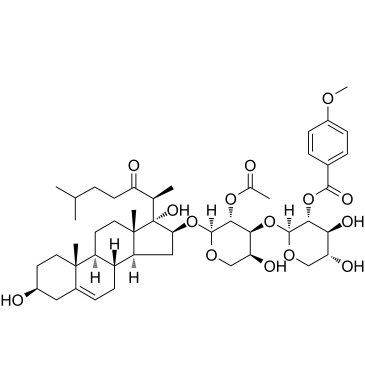| Description: |
OSW-1, isolated from Ornithogalum caudatum, is a specific antagonist of osterol-binding protein (OSBP) and OSBP-related protein 4 (ORP4) with GI50s in the nanomolar range in human cancer lines. |
| Target: |
OSBP/ORP4[1]. |
| In Vivo: |
To ascertain whether or not OSW-1 is as effective in vivo, a nude mouse model inoculated by LoVo cells is adopted, in which OSW-1 treatment is performed when tumors became palpable. The results show that the size of tumors in treated mice is smaller on average than control mice. The significant difference is observed from the 15-17 th day following treatment, and this difference is gradually increased until the animals are sacrificed. Compared with the control group, the tumor weight of the OSW-1-treated group significantly decreases (P<0.05). Additionally, no apparent side effects are observed in OSW-1-treated mice. These results demonstrate that OSW-1 has powerful effects on suppressing colon tumor growth without significant side effects in vivo[2]. |
| In Vitro: |
OSW-1 has a strong inhibitory effect on colon carcinoma cells with low cytotoxicity on normal cells. The anti-proliferative effects of OSW-1 on SW480 and LoVo colon carcinoma cells are characterized by measuring cell viability using the CCK8 assay, and compared the results with other clinical anticancer agents. SW480 and LoVo cell lines are derived from a Dukes' stage B colon carcinoma and a colon carcinoma metastatic nodule, which represent non-metastatic and metastatic carcinomas, respectively. OSW-1 exhibits not only extremely strong anticancer activity in SW480 and LoVo cell lines with an IC50 of nanomolar concentration, but is also more potent than other anticancer agents by 10-100 times, with a lower cytotoxic effect on normal epithelial cells. These results indicate that OSW-1 has a powerful anticancer effect, but lower cytotoxic effect on normal cells[2]. |
| Cell Assay: |
To observe the effect of OSW-1 on cell viability, the colon cancer cell lines LoVo and SW480 cells are seeded in 96-well plates at a concentration of 1×105 cells/well. Following overnight incubation, the cells are treated with several concentrations of OSW-1 (11.25, 22.5, 45, 90, 180 ng/mL) and incubated at 37°C in 5% CO2 for 24, 48, and 72 h. Cell viability analysis is determined using a Cell Counting Kit-8 Assay. Each assay is performed in quintuplicate and repeated three times[2]. |
| Animal Administration: |
Mice[2] Four-week-old male nude mice are used. Animals are acclimatized to the animal housing facility for a period of 7 days before the beginning of the experiments. LoVo human colon cancer cells (5x106 cells in 100 μL) are injected subcutaneously into the right flank of 18 nude mice. When the tumor becomes palpable, the nude mice are randomized into two groups: i) intraperitoneal injection of PBS (500 μL) daily in 9 nude mice; and ii) intraperitoneal injection of OSW-1 (0.01 mg/kg diluted in PBS in 500 μL) daily in 9 nude mice. The body weights of the animals and tumor size are recorded every day, and the tumor volume is calculated[2]. |
| References: |
[1]. Burgett AW, et al. Natural products reveal cancer cell dependence onoxysterol-binding proteins.Nat Chem Biol. 2011 Aug 7;7(9):639-47.
[2]. Zhang Y, et al, Effective cytotoxic activity of OSW-1 on colon cancer by inducing apoptosis in vitro and in vivo.Oncol Rep. 2017 Jun;37(6):3509-3519. |






















